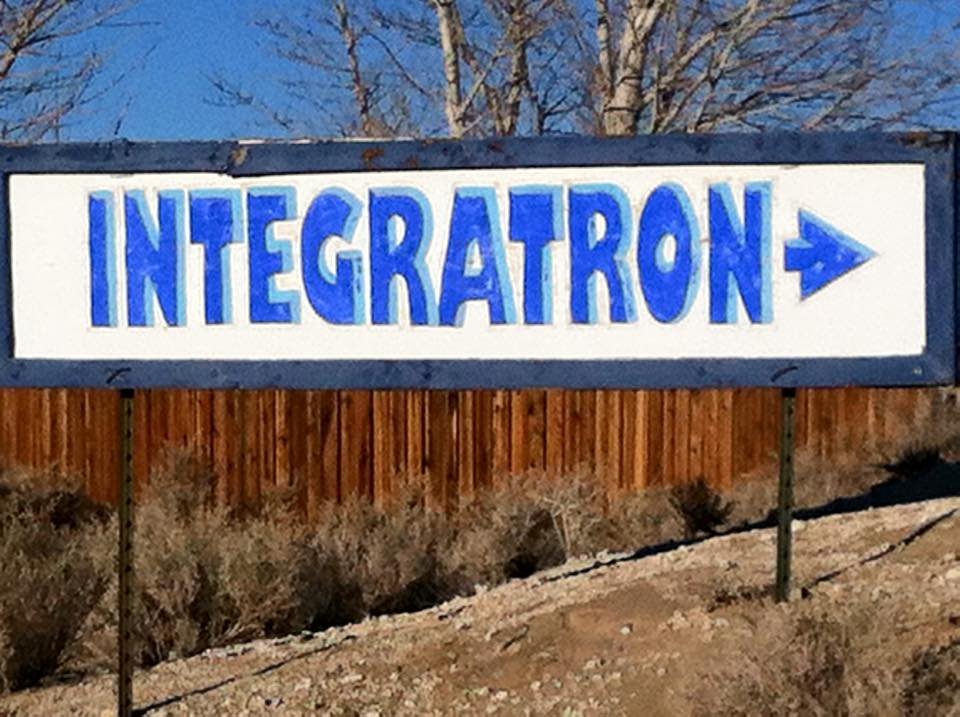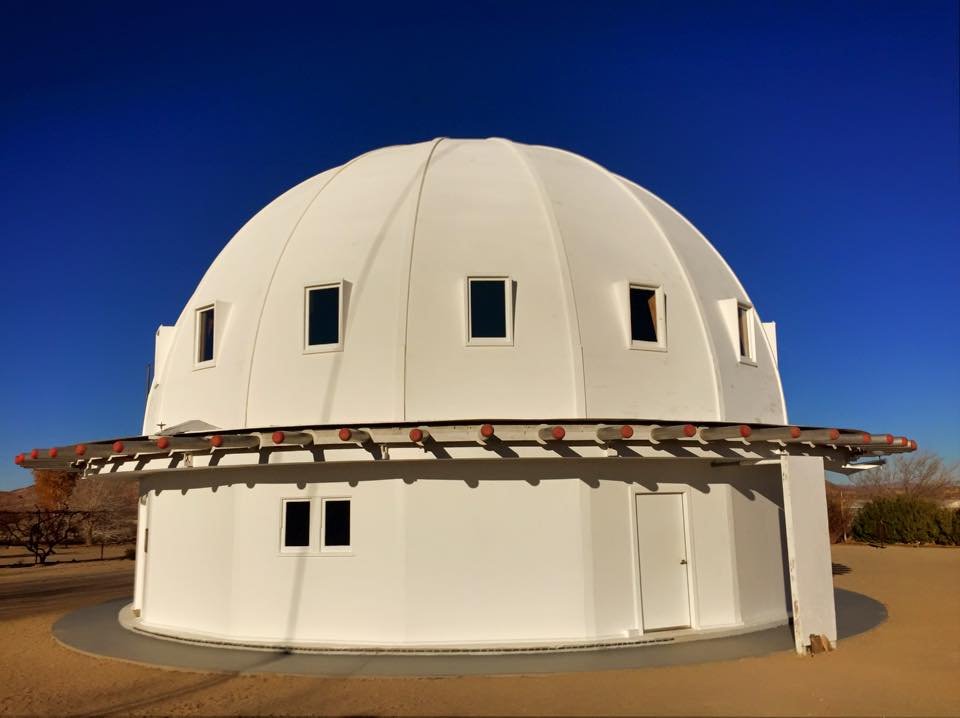The Integratron: Making Waves in America
The Integratron is not a secret. The day we went to visit at the very end of 2014, they had to turn away over 100 people. America knows about the Integratron, and people are drawn to the remote location outside of Joshua Tree, California from far and wide.
What is it? The Integratron itself seems tickled by this question — and yes, I mean to speak of it as a sort of self-aware entity. The original story from its creator, the aircraft mechanic and wide-eyed ufologist George van Tassel, was that aliens from Venus transmitted the instructions to build the Integratron as a healing technology involving “intermittent magnetic fields” and “plasma” and “coronal discharges” and what-have-you. It’s an acoustically perfect domed structure made out of non-magnetic materials (including wooden ship beams donated by Howard Hughes, the staff told us), which van Tassel built on top of one of those alleged geomagnetic vortexes for the purpose of rejuvenating human tissue. All accounts indicate that van Tassel was quite earnest about all this.
Whether this was marketing genius or madness, the story worked well enough to raise funds and build the structure in 1959, and it’s more popular than ever today. Maybe it doesn’t even matter how serious the alien stuff was — this used to be the kind of kitschy drama needed to draw Americans out to such far-flung desert roadside attractions. The Integratron has gone through a series of owners since van Tassel’s death in 1978, and the language has changed. The Integratron website downplays the weirdo history and makes a more reverent pitch. And even that is a bit understated compared to what we got from the staff when we arrived.
So, what is it? You really do have to go there to find out. We stepped out of the car onto a sandy lot with a funky, ramshackle hacienda, a handful of bizarre open-air art structures, and the sleek, white dome of the Integratron itself. The property was full of people milling around in winter clothing. It was barely 40 degrees that day, prompting the staff to cancel the evening session, so ours was going to be cozy. The staff seemed a bit harried, but they were smiling, and they ushered us into the dome.
The ground floor was decorated with weird art and historical clippings about the Integratron, and opposite the door was a sturdy ladder leading up to a trap door in the ceiling. The white-bearded guardian of the ladder thanked us all profusely for coming and supporting the Integratron and its keepers. It was a surprisingly touching greeting. He encouraged us to watch our steps up the ladder, take off our shoes when we reached the top, refrain from unnecessary conversation, find a spot, and relax. “You’re just here to be here,” he said. “You don’t have to do anything else.”
The Integratron chamber is a magical attic. The vaulted, wooden, perfect dome culminates in an impressive acoustical ring 38 feet above the center of the room. If you stand in the center, tilt back your head, and speak up into the ring, you can hear yourself loudly and clearly, but no one else in the room can. If you stand against the wall, you can whisper back and forth across the 50-foot diameter to someone standing opposite you. It’s an absolutely spellbinding acoustic environment.
IMAGE FROM INTEGRATRON.COM
Portholes let in sunlight and the color of the sky. On one side of the room is an altar covered with religious icons, which I noted to check out after the session. On another side is a set of large, white crystal singing bowls.
The floor is laid out with wool blankets and pillows, and the 40 or so chilly people in woolen socks quickly snuggled up. An excited (nervous?) silence charged the room. After a short while, a musician took his seat amidst the crystal bowls. “Wow! Y’all are so quiet!” he said with genuine astonishment. He introduced himself and greeted us with a touching thank-you for coming. He was one of several performers that switch off facilitating the Integratron sessions, he explained. He called the experience a “sound bath.”
Each sound bath is different, because the performance is improvised by different players, but the effect is comparable. It causes all the bodies in the room to resonate harmonically. He didn’t go into quite the theoretical detail that some of the written material does about the sound bath’s effects, but he did explain that, as beings made of mostly water, our “bodies really like this,” and he assured us that it would “clear our chakras.” I smiled and mused for a moment about the spread of pseudo-Eastern spiritual vocabulary to American roadside attractions. This was one of the last rational thoughts I had for the rest of the day. The performer then demonstrated the sound bath, just to give us a sense of the volume.
A loud, clear, pure, unwavering, unending tone.
A ripple of awed, quiet laughter crossed the room as the demonstration tone faded away. The performer was just as excited as he asked us to settle in and get ready to begin what he called the “accelerated meditation.” The sound bath would last for about half an hour, he explained, and then he would let us come back gradually, at our own pace.
The sound bath began.
The sound has no edges. It is round and smooth. At times it condenses down to one sound, at other times it diverges into two or three, maybe more, all symmetrical and distinct, like a hall of mirrors. It moves through the body programmatically, scanning gently for roughness and smoothing it out. The sounds cause colors and patterns in the mind. It is indeed pleasant the way a bath is pleasant, and it feels as cleansing. Under these waves for half an hour, the trance becomes stable, whole, womblike.
When the tones began to fade out, a wave swelled in me, first loss and sorrow, then fear, then relief, then ecstatic joy. Silence sat patiently in the room as we all came to and sat up, one by one. I looked around and saw the afterglow on every face. Overcome with gratitude, I went to the altar.
Dozens of icons of all different faiths had been placed lovingly on the table. The sign explained that they were all offerings from guests; the Integratron itself had no particular spirituality or faith. Seeing no Jewish icons, I felt the need to leave something.
Days before, my father had given me a necklace with a charm shaped like a Torah scroll, which I was wearing around my neck, something he no longer wanted and knew I would value. I loved it as an icon, but it was a little overt for my style. With his permission, I left the Torah necklace on the altar, next to the crystals.
Leaving the Integratron, the indwelling gratitude remained. I thanked each of the workers, and I thanked my family who came with me, and each thank-you was received with a knowing smile.
Was this a religious experience? That question needs unpacking. It was for me, as a religious person, as for the many others who have left religious offerings in the Integratron. Religious language and symbolism are my preferred tools for integrating my experiences, but as one can plainly see on the Integratron’s altar, the many spiritual languages are totally interchangeable there.
The Integratron itself imposes no such language; I’m sure there are other performers who wouldn’t use the word “chakra,” like ours did. That was his own language. I happen to indulge in the word “chakra” here and there, so I related to it, but my brother, for example, definitely does not, yet he clearly had an analogous experience feeling the waves of the sound bath passing methodically through various focal points in his body.
Religious vocabularies are techniques for understanding ineffable, emotional, transrational experiences. The Integratron is an exquisitely designed technology for inducing such experiences. It does so directly through the body, bypassing rational filters, putting the mind in a position of pure, helpless reaction. “Accelerated meditation,” the performer called it before the sound bath began. Even as a Zen practitioner, I accept that label. The Integratron is an innovation in spiritual technology, and America is flocking to it to see what the buzz is about.






